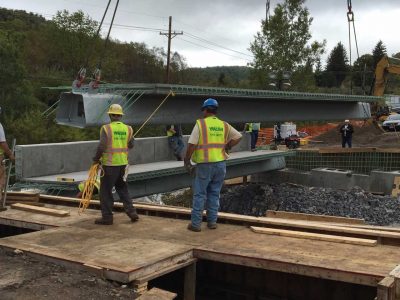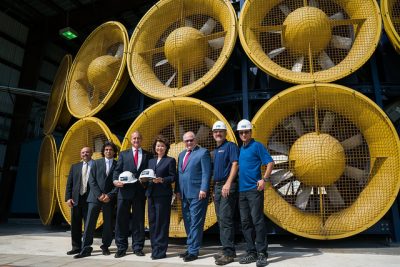
U.S. Secretary of Transportation Elaine L. Chao and U.S. Rep. Mario Diaz-Balart made a stop last week at the College of Engineering & Computing. During their visit, they toured FIU’s Accelerated Bridge Construction University Transportation Center (ABC-UTC) and the Wall of Wind (WOW).
Both the ABC-UTC and the WOW are federally designated research centers that allow for the study of best practices and research and development in infrastructure construction.
With a major transportation federal infrastructure bill expected in the next year, many of FIU’s technologies offer creative approaches to upgrade the current transportation system in a more rapid, cost-effective manner without compromising safety, particularly in rural areas.
Chao and Diaz-Balart, who is the chairman of the Transportation, Housing and Urban Development Appropriations Subcommittee and whose district includes FIU’s Engineering Center, met with FIU President Mark B. Rosenberg, College of Engineering & Computing Dean John Volakis and Atorod Azizinamini, director of the ABC-UTC at the Titan Materials Construction Lab at the Engineering Center. They discussed university-developed technologies and solutions being developed.
“Once again, FIU proves itself an essential solutions center for our country. These accelerated bridge construction technologies will surely help address the needs of our aging national infrastructure in a cost-effective manner with less disruption to our communities and their economies,” said Chairman Diaz-Balart.

FIU leaders stressed the need for a national clearinghouse for accelerated bridge engineering technologies, and their vision for a larger catastrophic technology research program. They also elaborated on federal laws that should be changed to facilitate innovative solutions into the market.
“It was an honor to host Secretary Chao and Congressman Diaz-Balart and show them how our researchers, including Dr. Azizinamini and our Wall of Wind team, are working on groundbreaking solutions to the critical issues of infrastructure and natural disasters,” Rosenberg said. “We look forward to continuing this conversation, of how FIU can collaborate with national decision makers to make our communities safer.”
ABC-UTC is developing cutting-edge technologies to upgrade and retrofit the nation’s substandard bridges using advanced materials, such as ultra-high performance concrete. Damaged bridges could be upgraded, without interrupting traffic at 10 percent of the replacement cost, Azizinamini said. He also elaborated on the development of economical bridge systems that could be assembled over a weekend and that are best suited for rural areas, where the majority of substandard bridges are located. Another benefit is that these systems could be built using local workers, resulting in workforce and economic development in communities.

“This visit provided an opportunity to provide an overview of select activities at ABC-UTC that are having a major impact in the bridge industry in the U.S.,” said Azizinamini, who is also the chair of the Department of Civil and Environmental Engineering.
During the visit, Chao and Diaz-Balart also toured FIU’s Wall of Wind, a state-of-the-art facility that simulates hurricane-strength wind gusts for engineering and resilience testing. WOW is one of eight facilities nationwide designated by the National Science Foundation as a National Hazards Engineering Research Infrastructure testing facility.






